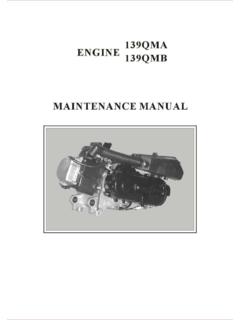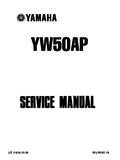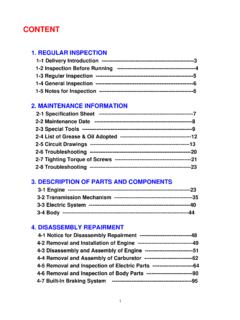Transcription of KEEWAY 50cc Models - 49ccscoot.com
1 SCOOTER SERVICE MANUAL KEEWAY 50cc Models KEEWAY AMERICA, LLC SPRING 2008 2 If problems cannot be resolved or further assistance is needed, please feel free to contact us. KEEWAY AMERICA, LLC 2912 SKYWAY CIRCLE N. IRVING, TX 75038 214-441-9661 PHONE 214-441-9641 FAX Our support staff will assist in any way possible. 3 PRE-DELIVERY INSPECTION In order for KEEWAY America to maintain its high standards of quality, it is necessary for each dealer to thoroughly inspect each unit before their customer takes delivery. INITIAL: Wash entire vehicle with warm water and wipe dry with a soft cloth. DO NOT USE SOAP OR TERRY CLOTH. Inspect paint sheen and decal quality. Ensure all fasteners have appropriate torque, to include visible body screws, axle and exhaust nuts, engine and carburetor bolts, etc. Ensure proper operation of all lock cylinders. Verify that a new, fully charged battery has been installed. Inspect vehicle electrical system, including switch and control operations.
2 Ensure proper operation and adjustment of levers, throttle and rear brake cables. Ensure proper front and rear brake operation, including fluid level, and adjust as needed. Verify spark plug gap, and adjust accordingly. Start engine and bring to operating temperature. Check fluid levels, and add if necessary. Check and adjust idle speed as needed. Ensure free travel of both wheels. Check tire pressure, and adjust accordingly. Verify proper operation of remote-start system. 4 TEST DRIVE: Verify proper front and rear suspension for correct damping and travel. Ensure proper operation and settings of gauge cluster. Verify wheel alignment, and adjust accordingly. Check for fluid leaks, and adjust levels accordingly. Verify proper operation and adjustment of all vehicle lights. FINAL: Wipe down entire vehicle with soft cloth to remove any dust or debris. Detail grips, seat, and tires. 5 MAINTENANCE CHART 6 TABLE OF CONTENTS_____ PREDELIVERY INSPECTION MAINTENANCE CHART PREFACE KEEWAY SERVICE GUIDELINES ELECTRICAL PRECAUTIONS SAFETY GUIDELINES SPECIALTY TOOLS REQUIRED GENERAL INFORMATION Terminology The 2-Stroke Engine Cycle Vehicle Information General Specifications POWERTRAIN SPECIFICATIONS Fastener Torque DIMENSIONS Alignment Pins/Dowels Pin shafts O-rings Seals Bearings Gaskets Gears Sprockets Chains ENGINE PARTS ORIENTATION 7 ENGINE COMPONENT FIT/TOLERANCE Cylinder Head/Valve Cylinder Jug/Piston SYSTEM FUNDAMENTALS Kick Start Chain Reaction Fuel Delivery System Brake System Fundamentals Fundamental Front Absorber Theory TROUBLESHOOTING AND PROCEDURES COMMON ISSUES Electric Starter Doesn t Engage or Rotate Only Clicking Noise When Starter Button Is Pressed No Reaction Whatsoever When Starter Button Is Pressed Hard Start/Poor Idle/Poor Performance No Start Insufficient Power/Lack of
3 Acceleration Poor/Difficult Handling/Instability Soft Brakes or Too Much Lever Travel Hard Brakes or Stiff Lever Feel BATTERY/CHARGING SYSTEM FUNDAMENTAL TEST ENGINE COMPRESSION TEST IGNITION TIMING TEST TECHNICAL GUIDE FOR 50cc CARBURETORS 8 POWERTRAIN COMPONENTS CARBURETOR REMOVAL/INSTALLATION ENGINE AND COMPONENTS REMOVAL/INSTALLATION Cowling Assembly Cylinder Head Assembly Camshaft/Rocker Arm Assembly Piston Assembly LH Crankcase Cover RH Crankcase Cover, Magneto, and Associated Parts RH Crankcase Internals LH Crankcase Cover and Associated Parts Crankcase Assembly Transmission Case Assembly Drive Wheel Clutch Assembly Kick Start Gear Assembly Transition Gear Assembly Variator Assembly Starter Clutch Assembly CHASSIS TORQUE SPECIFICATIONS COMPONENT GUIDE Front Wheel Assembly Rear Wheel Assembly Exhaust Assembly Front Fork Assembly 9 PREFACE_____ This service manual serves as KEEWAY America s promise of quality service and technical support for its entire line of vehicles.
4 This manual is intended to provide most of the necessary information for the proper service and maintenance of all 50cc scooters. KEEWAY 50cc scooters lie on the cutting edge of technology, offering such creature comforts as: Fully-automatic, belt-driven transmission Forced air-cooling system CDI ignition system Electric start with security system/remote start capabilities These 50cc scooters are intended to fit the needs of a wide array of potential riders. In order to remain familiar with the proper service procedures, authorized technicians should periodically review this manual. Please understand that this service manual acts as a general guide for KEEWAY s entire line of 50cc, 2-stroke scooters. Model-specific information such as vehicle specifications, wiring diagrams and technical/service bulletins will follow, keeping this guide as complete and current as possible. For any questions or concerns not addressed in this service manual or any succeeding documents, please don t hesitate to contact KEEWAY America directly.
5 10 KEEWAY SERVICE GUIDELINES 1. Use only genuine KEEWAY parts, and use proper lubricants where specified. 2. Use only the proper tools for the task at hand. 3. Please be sure to replace all washers, seals, o-rings, cotter pins, etc. 4. Please note that all fasteners are metric. 5. When reassembling fasteners, please snug nuts and bolts in a circular pattern, and torque to spec in a diagonal, star pattern (if applicable). 6. Upon completion of assembly, double check fastener tension (torque) and ensure free movement of parts. 7. Parts and fasteners should be free of debris prior to measurement. Upon assembly, use lubricant, or thread lock as needed. 8. When metal parts are removed, and need to be stored for extended periods, please apply a heavy coat of lubricant to minimize rust and debris accumulation. ELECTRICAL PRECAUTIONS A loose or dangling cable is a tremendous hazard. Ensure fasteners are in place and secure. Never leave wire exposed, especially near any metal surface, including nuts and bolts.
6 Only lay wire in straight, relaxed manner. Never stretch, twist, or sharply bend wire or electrical connectors, or loss of conductivity will occur. Keep wires away from heat sources and moving parts/rotating assemblies to avoid electrical damage. Inspect pigtails and connectors before connecting to wire to ensure a clean, firm contact. When making repairs to wires and connectors, please be sure to wrap the new joint in heat-shrink tubing. This will reinforce the connection and protect it from the elements. 11 SAFETY GUIDELINES WARNINGS: Use only the appropriate, well-maintained tool for the task at hand. Gasoline is a highly volatile chemical, and should be treated with care. Never handle near open flame or heat source. Keep floor clean and free of debris. Avoid fluid spills to minimize the risk of accidents and equipment damage. Exhaust fumes are hazardous to your health. Never operate engine in closed or poorly ventilated areas.
7 BRAKE DUST CONTAINS ASBESTOS. Use of a dry brush or compressed air will increase the risk of inhaling asbestos fibers, which carries a high risk of damage to the respiratory system. AVOID EYE AND PROLONGED SKIN CONTACT with brake cleaner. If this occurs, immediately and thoroughly flush affected area with water and seek medical assistance. Only use DOT-approved brake fluid from a sealed container to ensure no moisture absorption. Avoid fluid splash/overflow onto painted or rubber parts, as rapid deterioration can occur. BATTERIES CONTAIN ELECTROLYTE SOLUTION. Exercise caution and wear protective clothing and eyewear. If accidental exposure occurs, immediately and thoroughly flush affected area with water and seek medical assistance. Please maintain sufficient communication with coworkers to maintain productivity and minimize accident potential. 12 SPECIALTY TOOLS REQUIRED T01 T-Driver and socket set (8, 10, 12, 13mm, and screwdriver bits needed) T02 Flywheel removal tool T03 Valve spring compressor T04 Spanner socket T05 Cylinder compression tester T06 Piston pin removal tool 13T07 13/16 Spark plug socket (2 styles shown) T08 Impact wrench T9 Impact sockets (17 & 18mm needed) T10 Clutch clamp tool T11 Torque wrench (and appropriate sockets) Recommend both lbs-ft and lbs-in 14 GENERAL INFORMATION_____ TERMINOLOGY The two absolute maximums of linear piston travel in the internal combustion engine are referred to as TOP DEAD CENTER (TDC) and BOTTOM DEAD CENTER (BDC).
8 Note that TDC is at the point farthest from the rotation center of the crankshaft, and BDC is the closest point. The distance across the piston s sleeve, or cylinder, is known as CYLINDER DIAMETER. The STROKE is the distance the piston travels from TDC to BDC. The cylinder s DISPLACEMENT is achieved by calculating the cylinder s volume (by multiplying ( DIAMETER) * *STROKE), all in centimeters. (NOTE: total engine displacement is achieved by multiplying this number by the total number of cylinders.) The end measurement is cubic centimeters, or cc. 15 THE 2-STROKE ENGINE CYCLE The 2-stroke engine differs slightly from the 4-stroke, in that it combines its phases, or strokes. Upon initial inspection, the most noticeable difference in overall 2-stroke architecture is the location of the INTAKE PORT. It provides a direct feed into the CRANKCASE, and then moves into the CYLINDER via the TRANSFER PORT. The following better describes the process. At the beginning of the engine s first revolution, the piston begins an upward motion in the cylinder, which generates pressure in the combustion chamber, and creates a vacuum into the CRANKCASE.
9 NOTE: The piston skirt is blocking the transfer and exhaust ports, but is allowing the air/fuel mix to enter the crankcase via the intake port. 16 Now the piston is reaching TDC, completely compressing the air/fuel mix in the combustion chamber. NOTE: The exhaust and transfer ports are still blocked by the piston skirt; the intake port is still open, but the crankcase has now filled to capacity. The spark plug now fires, igniting the compressed mixture in the combustion chamber. Once the mix has been ignited, the following explosion forces the piston back down at a very high rate of speed. This generates the power required to perform the workload. NOTE: All three ports are now closed. As this downward motion occurs, the air/fuel mixture in the crankcase is compressed. 17 This is the final, and perhaps most complicated step in the 2-stroke process. As the piston travels downward, the EXHAUST PORT opens. This allows the combusted gasses to exit the engine.
10 As the piston continues downward, the TRANSFER PORT is now exposed. This allows for the compressed mix in the crankcase to expand and enter the cylinder. NOTE: The intake port remains closed. As the piston reaches BDC, a new cycle begins. This cycle of the 2-stroke engine translates into a fundamental rotational force inflicted upon the crankshaft, known as TORQUE. This force is translated to the vehicle s drive wheel via a clutch assembly and drive belt. The metric unit of measurement for TORQUE is equal to the unit of force multiplied by the length of the arm that inflicts it, which is the Newton-meter (lb-ft standard). In order to optimize the efficiency of this engine cycle and maximize TORQUE output, the timing of ignition of the compressed air-fuel mixture is managed by the vehicle s CDI. 18 VEHICLE INFORMATION Engine Number The engine number is stamped into the rear of the crankcase, as shown in the illustration. Fuel Be sure to only use unleaded fuel, 90 Octane or better.






